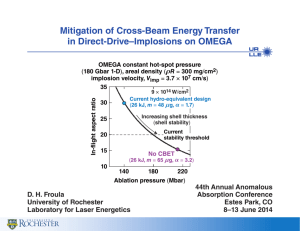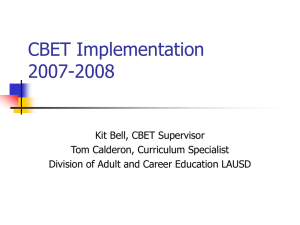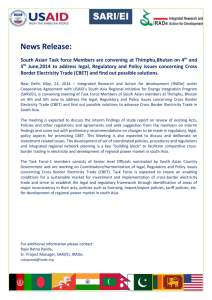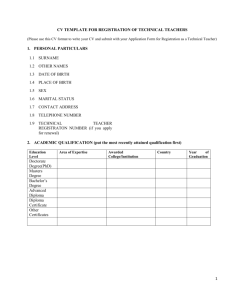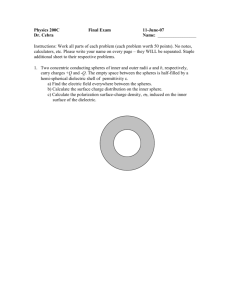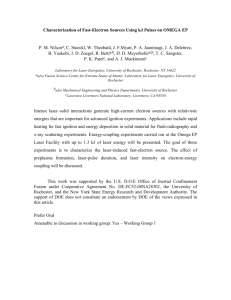Mitigation of Cross-Beam Energy Transfer in Direct
advertisement
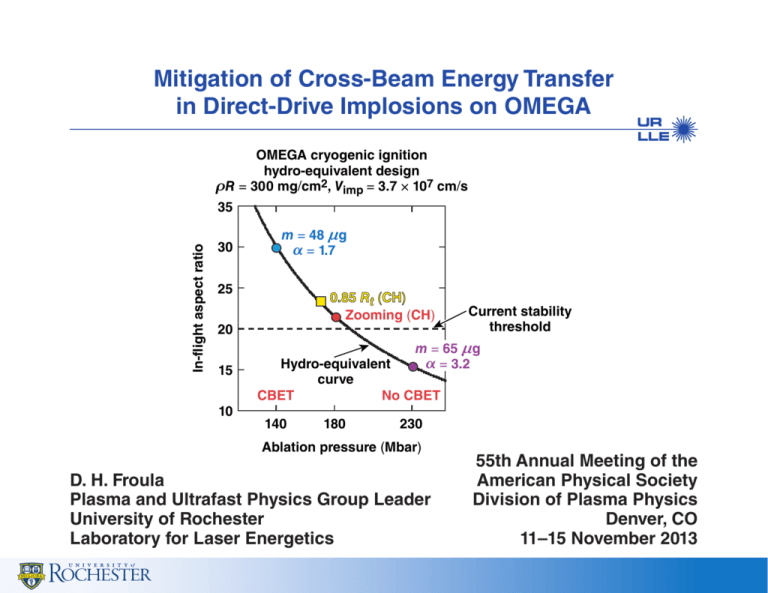
Mitigation of Cross-Beam Energy Transfer in Direct-Drive Implosions on OMEGA OMEGA cryogenic ignition hydro-equivalent design tR = 300 mg/cm2, Vimp = 3.7 × 107 cm/s In-flight aspect ratio 35 30 m = 48 ng a = 1.7 25 0.85 Rt (CH) Zooming (CH) 20 15 10 Current stability threshold m = 65 ng a = 3.2 Hydro-equivalent curve CBET No CBET 140 180 230 Ablation pressure (Mbar) D. H. Froula Plasma and Ultrafast Physics Group Leader University of Rochester Laboratory for Laser Energetics 55th Annual Meeting of the American Physical Society Division of Plasma Physics Denver, CO 11–15 November 2013 Summary Reducing cross-beam energy transfer (CBET) on OMEGA will allow for more stable ignition-relevant implosions • CBET can be mitigated by reducing the diameter of the laser beams • Mitigating CBET increases the ablation pressure, allowing for thicker shelled targets and higher adiabats • Two approaches are being investigated on OMEGA to reduce the laser beams – smaller laser spots—reduced beam-to-beam overlap – two-state zooming—increased single-beam imprint Experiments to validate these schemes are underway. E22428 Collaborators T. J. Kessler, I. V. Igumenshchev, V. N. Goncharov, H. Huang, S. X. Hu, E. Hill, J. H. Kelly, D. T. Michel, D. D. Meyerhofer, A. Shvydky, J. D. Zuegel, and R. Epstein University of Rochester Laboratory for Laser Energetics CBET reduces the energy coupled to the fusion capsule k1 CBET is spatially limited near M ~ 1 k2 Energy is transferred between beams by ion-acoustic waves ka Target E19971d CBET reduces the most hydrodynamically efficient portion of the incident laser beams. CBET modeling is required to match the experimental observables (scattered light, implosion velocity, and bang time)* 1225 ps 1280 ps 1330 ps 1385 ps 1825 ps 1880 ps 1930 ps 1985 ps** Simulations (Nonlocal + 500 25 CBET models) 20 400 20 15 200 10 5 100 5 0 0 0 3 10 0 1 2 t (ns) 3 0 1 2 t (ns) V (km/s) Data 300 20 300 P (TW) 15 Simulations (Nonlocal + CBET models) 400 25 15 200 10 Data 100 0 0 1 2 t (ns) P (TW) Simulations (Nonlocal + CBET models) 25 R (nm) P (TW) 760 nm 5 0 3 CBET reduces the ablation pressure by ~45%. E22473a *I. V. Igumenshchev et al., Phys. Plasmas 19, 056314 (2012). **D. T. Michel et al., Rev. Sci. Instrum. 83, 10E530 (2012). Experiments have demonstrated that CBET can be mitigated by reducing the radius of laser beams 0.3 CBET model 0.2 0.8 0.1 0.0 0.4 0.7 0.9 0.6 0.8 1.0 Rbeam/Rtarget 1.0 1.2 In-flight aspect ratio 35 Absorption fraction Scattered-light fraction OMEGA cryogenic hydro-equivalent design tR = 300 mg/cm2, Vimp = 3.7 × 107 cm/s 30 m = 48 ng a = 1.7 25 20 15 10 Current stability threshold* 0.85 Rt (CH) Hydroequivalent curve CBET m = 65 ng a = 3.2 No CBET 140 230 180 Ablation pressure (Mbar) Reducing the radius of the beams will allow the thickness of the shell and the adiabat to be increased in a hydro-equivalent design but the reduced overlap uniformity may increase the imprint. E20145g *D. H. Froula et al., Phys. Rev. Lett. 108, 125003 (2012). *V. N. Goncharov, GI3.00001, this conference (invited). Simulations suggest that reducing the beam diameters by 20% (Rb/Rt = 0.8) will have minimal impact on the hotspot symmetry 2-D DRACO simulations (low-order nonuniformities only) 40 Rb/Rt = 1.07 YOC = 1.0 r (nm) 30 20 10 0 0 10 20 30 z (nm) Rb/Rt = 0.8 YOC = 0.94 t (g/cm3) 361 Rb/Rt = 0.7 YOC = 0.62 t (g/cm3) 352 t (g/cm3) 426 241 234 284 122 117 142 1 0 0 40 50 0 10 20 30 z (nm) 40 50 0 10 20 30 z (nm) 40 50 Reducing the beam diameters by more than 20% significantly degrades the target performance. TC9894 I. V. Igumenshchev et.al., Phys. Plasmas 19, 056314 (2012). Reducing the diameter of the laser beams beyond 20% after a sufficient conduction zone is generated (“zooming”) is predicted to maintain good low-mode uniformity v - 17 nm 20 10 0 0 10 20 30 40 r (nm) Rb/Rt = 1.0 20 15 r (nm) 30 Power (×1012 W) r (nm) rms deviation from round (v) Rb/Rt = 0.7 10 5 0 0 1 2 3 Time (ns) 4 30 v < 3 nm 20 360 10 0 0 t (g/cm3) 10 20 30 40 r (nm) 240 120 0 E21317l *I. V. Igumenshchev et al., Phys. Rev. Lett. 110, 145001 (2013). Reducing the diameter of the laser beams beyond 20% after a sufficient conduction zone is generated (“zooming”) is predicted to maintain good low-mode uniformity 20 10 0 0 10 20 30 40 r (nm) 20 Rb/Rt = 1.0 Rb/Rt = 0.7 15 10 5 0 Rb/Rt = 1.0 r (nm) v - 17 nm 30 Power (×1012 W) r (nm) rms deviation from round (v) Rb/Rt = 0.7 0 1 2 3 Time (ns) 4 30 v < 3 nm 20 360 10 0 0 t (g/cm3) 10 20 30 40 r (nm) 240 Zooming from Rb/Rt = 1.0 to 0.7 r (nm) 30 120 20 0 10 0 0 E21317m v - 12 nm 10 20 30 40 r (nm) *I. V. Igumenshchev et al., Phys. Rev. Lett. 110, 145001 (2013). Reducing the diameter of the laser beams beyond 20% after a sufficient conduction zone is generated (“zooming”) is predicted to maintain good low-mode uniformity 20 10 0 0 10 20 30 40 r (nm) 20 Rb/Rt = 1.0 Rb/Rt = 0.7 15 10 5 0 Rb/Rt = 1.0 r (nm) v - 17 nm 30 Power (×1012 W) r (nm) rms deviation from round (v) Rb/Rt = 0.7 0 1 2 3 Time (ns) 4 30 v < 3 nm 20 360 10 0 0 t (g/cm3) 10 20 30 40 r (nm) 240 Zooming from Rb/Rt = 1.0 to 0.7 r (nm) 30 v - 3.5 nm 120 20 0 10 0 0 E21317n v - 12 nm 10 20 30 40 r (nm) 0 10 20 30 40 r (nm) *I. V. Igumenshchev et al., Phys. Rev. Lett. 110, 145001 (2013). Reducing the diameter of the laser beams beyond 20% after a sufficient conduction zone is generated (“zooming”) is predicted to maintain good low-mode uniformity 20 10 0 0 10 20 30 40 r (nm) 20 Rb/Rt = 1.0 Rb/Rt = 0.7 15 10 5 0 Rb/Rt = 1.0 r (nm) v - 17 nm 30 Power (×1012 W) r (nm) rms deviation from round (v) Rb/Rt = 0.7 0 1 2 3 Time (ns) 30 20 t (g/cm3) 360 10 0 0 4 v < 3 nm 10 20 30 40 r (nm) 240 Zooming from Rb/Rt = 1.0 to 0.7 r (nm) 30 v - 3.5 nm v < 1.5 nm 120 20 0 10 0 0 E21317o v - 12 nm 10 20 30 40 r (nm) 0 10 20 30 40 r (nm) 0 10 20 30 40 r (nm) *I. V. Igumenshchev et al., Phys. Rev. Lett. 110, 145001 (2013). Power (×1012 W) Zooming can be implemented on OMEGA using a radially varying phase plate and a dynamic near field 20 15 10 5 0 0 1 2 3 Time (ns) 4 eld i f r a am n Dy e ic n Zooming phase plate (ZPP) Picket pulse Main pulse E22039b D. H. Froula et al., Phys. Plasmas 20, 082704 (2013). OMEGA cryogenic ignition hydro-equivalent design tR = 300 mg/cm2, Vimp = 3.7 × 107 cm/s 35 25 20 m = 65 ng Hydro-equivalent a = 3.2 curve CBET No CBET 140 180 230 Ablation pressure (Mbar) 25 20 15 10 e bl 10 0.85 Rt (CH) Zooming (CH) 30 ta 15 Current stability threshold In-flight aspect ratio 30 m = 48 ng a = 1.7 Hydro-equivalence for current implosions s Un In-flight aspect ratio 35 C th ur re re sh nt ol d Implementing zooming on OMEGA will provide a more-robust implosion to hydrodynamic instabilities 1.5 2.0 2.5 3.0 3.5 4.0 4.5 Adiabat tR/tR1-D >0.95 0.90 0.85 0.80 0.75 0.70 0.65 0.60 0.55 0.50 <0.50 Data Both CBET mitigation strategies on OMEGA will allow the mass of the shell and the adiabat to be increased while maintaining ignition-relevant conditions. E22229b T. C. Sangster et al., Phys. Plasmas 20, 056317 (2013). Summary/Conclusions Reducing cross-beam energy transfer (CBET) on OMEGA will allow for more stable ignition-relevant implosions • CBET can be mitigated by reducing the diameter of the laser beams • Mitigating CBET increases the ablation pressure, allowing for thicker shelled targets and higher adiabats • Two approaches are being investigated on OMEGA to reduce the laser beams – smaller laser spots—reduced beam-to-beam overlap – two-state zooming—increased single-beam imprint Experiments to validate these schemes are underway. E22428
